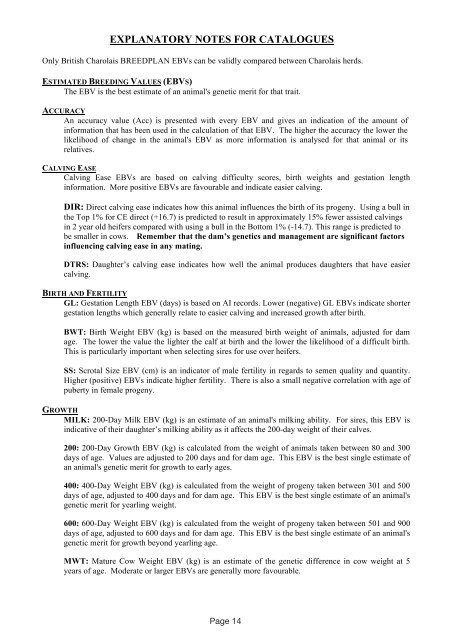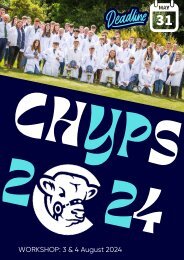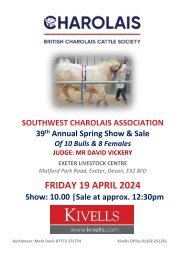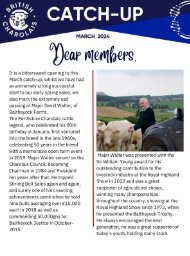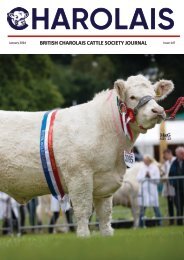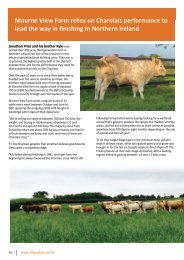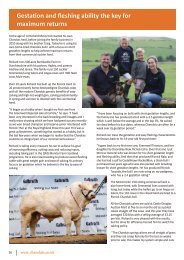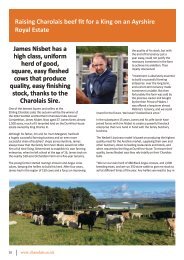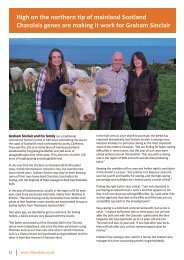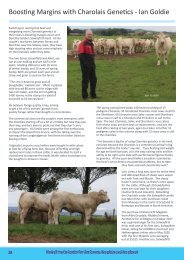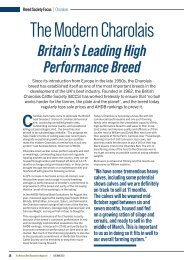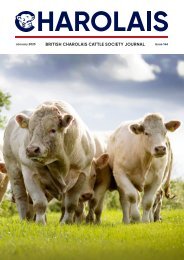WLS Charolais Catalogue April 2024 L2
Create successful ePaper yourself
Turn your PDF publications into a flip-book with our unique Google optimized e-Paper software.
EXPLANATORY NOTES FOR CATALOGUES<br />
Only British <strong>Charolais</strong> BREEDPLAN EBVs can be validly compared between <strong>Charolais</strong> herds.<br />
ESTIMATED BREEDING VALUES (EBVS)<br />
The EBV is the best estimate of an animal's genetic merit for that trait.<br />
ACCURACY<br />
An accuracy value (Acc) is presented with every EBV and gives an indication of the amount of<br />
information that has been used in the calculation of that EBV. The higher the accuracy the lower the<br />
likelihood of change in the animal's EBV as more information is analysed for that animal or its<br />
relatives.<br />
CALVING EASE<br />
Calving Ease EBVs are based on calving difficulty scores, birth weights and gestation length<br />
information. More positive EBVs are favourable and indicate easier calving.<br />
DIR: Direct calving ease indicates how this animal influences the birth of its progeny. Using a bull in<br />
the Top 1% for CE direct (+16.7) is predicted to result in approximately 15% fewer assisted calvings<br />
in 2 year old heifers compared with using a bull in the Bottom 1% (-14.7). This range is predicted to<br />
be smaller in cows. Remember that the dam’s genetics and management are significant factors<br />
influencing calving ease in any mating.<br />
DTRS: Daughter’s calving ease indicates how well the animal produces daughters that have easier<br />
calving.<br />
BIRTH AND FERTILITY<br />
GL: Gestation Length EBV (days) is based on AI records. Lower (negative) GL EBVs indicate shorter<br />
gestation lengths which generally relate to easier calving and increased growth after birth.<br />
BWT: Birth Weight EBV (kg) is based on the measured birth weight of animals, adjusted for dam<br />
age. The lower the value the lighter the calf at birth and the lower the likelihood of a difficult birth.<br />
This is particularly important when selecting sires for use over heifers.<br />
SS: Scrotal Size EBV (cm) is an indicator of male fertility in regards to semen quality and quantity.<br />
Higher (positive) EBVs indicate higher fertility. There is also a small negative correlation with age of<br />
puberty in female progeny.<br />
GROWTH<br />
MILK: 200-Day Milk EBV (kg) is an estimate of an animal's milking ability. For sires, this EBV is<br />
indicative of their daughter’s milking ability as it affects the 200-day weight of their calves.<br />
200: 200-Day Growth EBV (kg) is calculated from the weight of animals taken between 80 and 300<br />
days of age. Values are adjusted to 200 days and for dam age. This EBV is the best single estimate of<br />
an animal's genetic merit for growth to early ages.<br />
400: 400-Day Weight EBV (kg) is calculated from the weight of progeny taken between 301 and 500<br />
days of age, adjusted to 400 days and for dam age. This EBV is the best single estimate of an animal's<br />
genetic merit for yearling weight.<br />
600: 600-Day Weight EBV (kg) is calculated from the weight of progeny taken between 501 and 900<br />
days of age, adjusted to 600 days and for dam age. This EBV is the best single estimate of an animal's<br />
genetic merit for growth beyond yearling age.<br />
MWT: Mature Cow Weight EBV (kg) is an estimate of the genetic difference in cow weight at 5<br />
years of age. Moderate or larger EBVs are generally more favourable.<br />
Page 14


